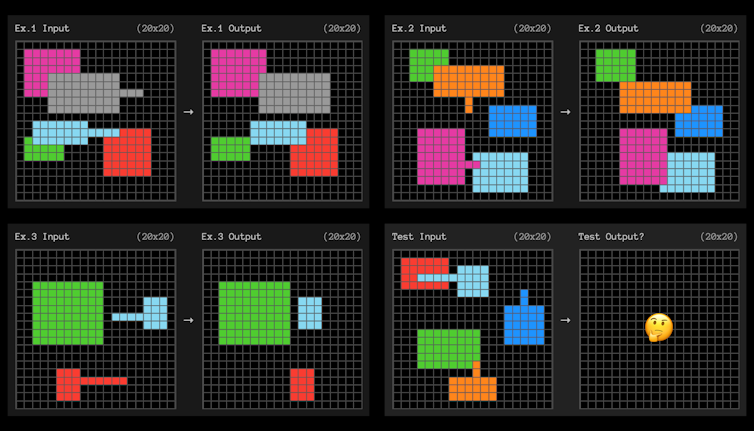
ARSTECHNICA.COM
After 60 years of spaceflight patches, here are some of our favorites
A picture's worth 1,000 words After 60 years of spaceflight patches, here are some of our favorites It turns out the US spy satellite agency is the best of the best at patch design. Eric Berger Dec 29, 2024 7:00 am | 0 NROL-61 is the iconic "Spike" patch. Credit: NRO NROL-61 is the iconic "Spike" patch. Credit: NRO Story textSizeSmallStandardLargeWidth *StandardWideLinksStandardOrange* Subscribers only Learn moreThe art of space mission patches is now more than six decades old, dating to the Vostok 6 mission in 1963 that carried Soviet cosmonaut Valentina Tereshkova into low-Earth orbit for nearly three days. The patch for the first female human spaceflight showcased a dove flying above the letters designating the Soviet Union, CCCP.That patch was not publicly revealed at the time, and the use of specially designed patches was employed only infrequently by subsequent Soviet missions. NASA's first mission patch would not follow for two years, but the practice would prove more sticky for missions in the United States and become a time-honored tradition.The first NASA flight to produce a mission-specific patch worn by crew members was Gemini 5. It flew in August 1965, carrying astronauts Gordon Cooper and Pete Conrad on an eight-day mission inside a small Gemini spacecraft. At the time, it was the longest spaceflight conducted by anyone.Robert Pearlman has the story behind the patch at Collect Space, which came about because of the wishes of the crew. During the initial Mercury missions, the pilots were able to name their spacecraftFreedom 7, Liberty Bell 7, and so on. Cooper had named his Mercury spacecraft 'Faith 7.' But an increasingly buttoned-up NASA ended this practice for the Gemini missions, and when Cooper and Conrad were assigned to the third Gemini flight they considered alternatives. Gemini 5 mission patch. Note the "8 days or bust" messaging on the wagon was covered up until after the mission was completed. Credit: NASA Gemini 5 mission patch. Note the "8 days or bust" messaging on the wagon was covered up until after the mission was completed. Credit: NASA "Several months before mission, I mentioned to Pete that I'd never been in a military organization that didn't have its own patch," Cooper recounted in Leap of Faith, his memoir. "We decided right then and there that we were at least going to have a patch for our flight."They chose a covered wagon design to indicate the pioneering nature of the mission and came up with the "8 days or bust" slogan to highlight the extended duration of the flight. Since then, virtually every NASA mission has included a patch design, typically with names of the crew members. The tradition has extended to non-human missions and has generally been adopted by space agencies around the world.As such, there is a rich tradition of space mission patches to draw on, and we thought it would be fun to share some of our favorites over the decades. Apollo 11 mission patch. NASA Apollo 11 mission patch. NASA The Apollo 13 mission patch is the only other Apollo Moon mission without names. The Apollo 13 mission patch is the only other Apollo Moon mission without names. The Apollo 17 mission patch had a lot going on. The Apollo 17 mission patch had a lot going on.The Apollo 13 mission patch is the only other Apollo Moon mission without names.The Apollo 17 mission patch had a lot going on.Apollo 11The first human mission to land on the Moon is one of the only NASA mission patches that does not include the names of the crew members, Neil Armstrong, Buzz Aldrin, and Michael Collins. This was a deliberate choice by the crew, who wanted the world to understand they were traveling to the Moon for all of humanity.Another NASA astronaut, Jim Lovell, suggested the bald eagle could be the focus of the patch. Collins traced the eagle from a National Geographic children's magazine, and an olive branch was added as a symbol of the mission's peaceful intent.The result is a clear symbol of the United States leading humanity to another world. It is simple and powerful. Skylab rescue mission patch. Credit: NASA Skylab rescue mission patch. Credit: NASA Skylab rescue missionSkylab was NASA's first space station, and it was launched into orbit after the final Apollo lunar landing in 1972. From May 1973 to February 1974, three different crews occupied the space station, which had been placed in orbit by a modified Saturn V rocket.Due to some problems with leaky thrusters on the Apollo spacecraft that carried the second crew to Skylab in 1973, NASA scrambled to put together a 'rescue' mission as a contingency. In this rescue scenario, astronauts Vance Brand and Don Lind would have flown to the station and brought Alan Bean, Jack Lousma, and Owen Garriott back inside an Apollo capsule especially configured for five people.Ultimately, NASA decided that the crew could return to Earth in the faulty Apollo spacecraft, with the use of just half of the vehicle's thrusters. So Brand and Lind never flew the rescue mission. But we got a pretty awesome patch out of the deal. STS-1 mission patch STS-1 mission patch STS-6 mission patch with a clean design. STS-6 mission patch with a clean design.STS-1 mission patchSTS-6 mission patch with a clean design. STS-7 showcases the robotic arm. STS-7 showcases the robotic arm. STS-8 nicely displays the power of the shuttle at launch. STS-8 nicely displays the power of the shuttle at launch.STS-7 showcases the robotic arm.STS-8 nicely displays the power of the shuttle at launch.Space shuttle programWith the space shuttle, astronauts and patch artists had to get more creative because the vehicle flew so frequentlyeventually launching 135 times. Some of my favorite patches from these flights came fairly early on in the program.As it turns out, designing shuttle mission patches was a bonding exercise for crews after their assignments. Often one of the less experienced crew members would be given leadership of the project."During the Shuttle era, designing a mission emblem was one of the first tasks assigned to a newly formed crew of astronauts," Flag Research Quarterly reports. "Within NASA, creation of the patch design was considered to be an important team-building exercise. The crew understood that they were not just designing a patch to wear on their flight suits, but that they were also creating a symbol for everyone who was working on the flight."In some cases the crews commissioned a well-known graphic designer or space artist to help them with their patch designs. More typically they worked with a graphic designer on staff at the Johnson Space Center to finalize the design. NROL-61 is the iconic "Spike" patch. NRO NROL-61 is the iconic "Spike" patch. NRO NROL-39 is mildly terrifying. NROL-39 is mildly terrifying. NROL-49 is downright apocalyptic. NROL-49 is downright apocalyptic.NROL-39 is mildly terrifying.NROL-49 is downright apocalyptic. This one is nice, except for the whole fire wielding thing. This guy doesn't look ominous at all. National Reconnaissance OfficeThe activities of the US National Reconnaissance Office, which is responsible for the design and launching of spy satellites, are very often shrouded in secret.However, the spy satellite agency cleverly uses its mission patches as an effective communications tool. The patches for the launch of its satellites never give away key details, but they are often humorous, ominous, and suggestive all at the same time. The immediate response I often have to these patches is one of appreciation for the design, followed by a nervous chuckle. I suspect that's intended by the spy agency.In any case, these are my choices for the best space patches ever, perhaps because they are developed with such abandon. The Soyuz TM-24 mission to Mir in 1996 carried ESA astronaut Reinhold Ewald. The Soyuz TM-24 mission to Mir in 1996 carried ESA astronaut Reinhold Ewald. The Soyuz T-6 mission to the Salyut 7 space station carried ESA astronaut Jean-Loup Chrtien in 1982. The Soyuz T-6 mission to the Salyut 7 space station carried ESA astronaut Jean-Loup Chrtien in 1982. Proxima was the name given to ESA astronaut Thomas Pesquets six-month mission on the International Space Station in 2016-2017. Proxima was the name given to ESA astronaut Thomas Pesquets six-month mission on the International Space Station in 2016-2017.The Soyuz T-6 mission to the Salyut 7 space station carried ESA astronaut Jean-Loup Chrtien in 1982.Proxima was the name given to ESA astronaut Thomas Pesquets six-month mission on the International Space Station in 2016-2017.European Space AgencyThe space agency that consists of a couple of dozen European nations has also created some banger patches over the years that both recognize the continent's long history of scientific discoverywith Newton, Kepler, Galileo, and Curie to name but a fewand the potential for future discovery in space.Attached are some of my personal favorites, which highlight the launch of European astronauts on the Russian Soyuz spacecraft to three different Russian space stations across three decades.What I like about the European mission designs is that they are unique and not afraid to break from the traditional mold of patch design. They're also beautiful! The Demo-2 mission patch is iconic in every way. The Demo-2 mission patch is iconic in every way. I love the way the Dragon's tail is shaped like an 8. I love the way the Dragon's tail is shaped like an 8. The "bunny" in this patch stands for BUtch and suNI. The "bunny" in this patch stands for BUtch and suNI. I love the way the Dragon's tail is shaped like an 8. The "bunny" in this patch stands for BUtch and suNI. This isn't a Dragon mission patch, but the SpaceX design for Starship's fifth flight test is too cool for school. SpaceX When you write a book that culminates with a single launch, you've got to buy the patch. SpaceX mission patchesIn recent years, some of the most creative patch designs have come from SpaceX and its crewed spaceflights aboard the Dragon vehicle. Because of the spacecraft's name, the missions have often played off the Dragon motif, making for some striking designs.There is a dedicated community of patch collectors out there, and some of them were disappointed that SpaceX stopped designing patches for each individual Starlink mission a few years ago. However, I would say that buying two or three patches a week would have gotten pretty expensive, pretty fastnot to mention the challenge designers would face in making unique patches for each flight.If you read this far and want to know my preference, I am not much of a patch collector, as much as I admire the effort and artistry that goes into each design. I have only ever bought one patch, the one designed for the Falcon 1 rocket's fourth flight. The patch isn't beautiful, but it's got some nice touches, including lights for both Kwajalein and Omelek islands, where the company launched its first rockets. Also, it was the first time the company included a shamrock on the patch, and that proved fortuitous, as the successful launch in 2008 saved the company. It has become a trademark of SpaceX patches ever since.Eric BergerSenior Space EditorEric BergerSenior Space Editor Eric Berger is the senior space editor at Ars Technica, covering everything from astronomy to private space to NASA policy, and author of two books: Liftoff, about the rise of SpaceX; and Reentry, on the development of the Falcon 9 rocket and Dragon. A certified meteorologist, Eric lives in Houston. 0 Comments
0 Комментарии
0 Поделились
116 Просмотры









